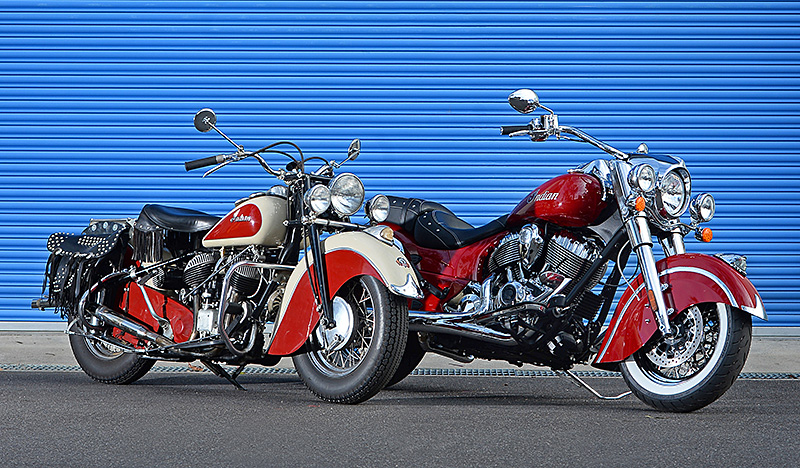Motorcycle Investor mag
Subscribe to our free email news
What's a Fake?
(with Guido series #306, October 2020)

by Guy ‘Guido’ Allen
Are we getting a little too cynical to accept revival brands?
I overheard an extraordinary conversation not so long ago. It was at the Phillip Island circuit, which was hosting the big annual historic cars meet. With some 500-ish competitors and an unbelievable mix of machinery, it’s a pretty big deal.
Muggins was strolling along the main spectator area, just past a display of new Polaris Indians set up by Antique Motorcycles ringmaster John G. Above the rumble of a gaggle of tin-tops on the track, from behind me I heard. “There’s some of those fake Indians.”
“Yeah,” piped in another, “They look like shit, don’t they?” Muttered agreement came from a third voice.
I looked behind me and none of the three blokes engaging in this conversation were an oil painting, so their style criticism seemed a little rich. Never mind, appearance and what appeals to us can be a very personal thing.
What really got my attention was the ‘fake’ comment. I could just picture the folk at the Polaris Spirit Lake factory reaching for the whiskey and muttering cruel incantations about philistines.
It’s not the first time I’ve heard the allegation. As the owner of two other generations of ‘fakes’, plus a ‘real’ Indian, I’ve copped it often enough. (The other ‘fakes’ are bikes from Gilroy and Kings Mountain – predecessors to Polaris.) Nevertheless I was surprised at the real venom in the tone of voice.
A ‘real’ Indian, in case you’re confused, was built from 1901 to 1953 in the Springfield factory. That’s how the traditionalists see it: no ‘proper’ Indian has been made since the historic facility closed its doors, 60-plus sodding years ago.
Now here’s something that strikes me as odd, the blokes I overheard looked like they may not have been born when that sad event happened – or if they were, they were in nappies. They certainly weren’t old enough to remember the factory and its bikes in their heyday. I could understand their attitude if they were. There are parts of our youth that we’ll all miss. But should we mourn a time we didn’t experience?
While holding a candle for an historic brand is admirable, you can take it too far. Indian went under probably because it was mismanaged and was too slow to develop its product. As the owner of a 1947 model (a ‘real’ one, remember!), I can promise you it’s essentially a 1930s motorcycle with a 1920s engine.
Indian’s modern equivalent is at least reasonably current. In fact, the Chief series is better equipped than many of its competitors.
I recall similar responses when Triumph relaunched from the Hinckley factory in the early 1990s. In that case the brand had been effectively dead for well over a decade, thanks to the collapse of the Meriden factory.
Hinckley, John Bloor’s revival factory, was received with a little skepticism at first until people realised just how massive the investment was and how determined they were to stay in business. Sure, there were accusations of them being Japanese bike clones rather than ‘real’ Triumphs. I don’t recall them being as vitriolic, maybe time has softened that memory. What I do recall is people teasing the Hinckley people.
Meriden Triumphs, in part because of their vertically split crankcases (who thought that up?!), were notorious for oil leaks. I remember one wag at a new Triumph rally slipping some fresh oil under a leak-free Daytona 1200 demo bike and calling over long-suffering staffer Gary McDonnell. “Hey Gaz,” he yelled at the top of his voice (no point in doing it if everyone doesn’t hear…), “Good to see they leak in the same place as the old ones!” I’m pretty sure there are laws against repeating Gary’s response.
In the case of Indian, it’s fair to say nothing other than styling cues have carried across, which is just fine. And while it’s fine to get misty-eyed about decades and factories long past, what would you rather see – an historic brand revived and running around, or less choice in the market?
What makes this pushback really hard to understand in Indian’s case is the brand has demonstrably remained an American-designed and built product. Surely that’s a good thing.
It took time, but the Hinckley bikes were eventually accepted by most as being ‘real’ Triumphs. Hopefully Polaris will have the same experience.
-------------------------------------------------
Produced by AllMoto abn 61 400 694 722
Privacy: we do not collect cookies or any other data.

Archives
Contact




